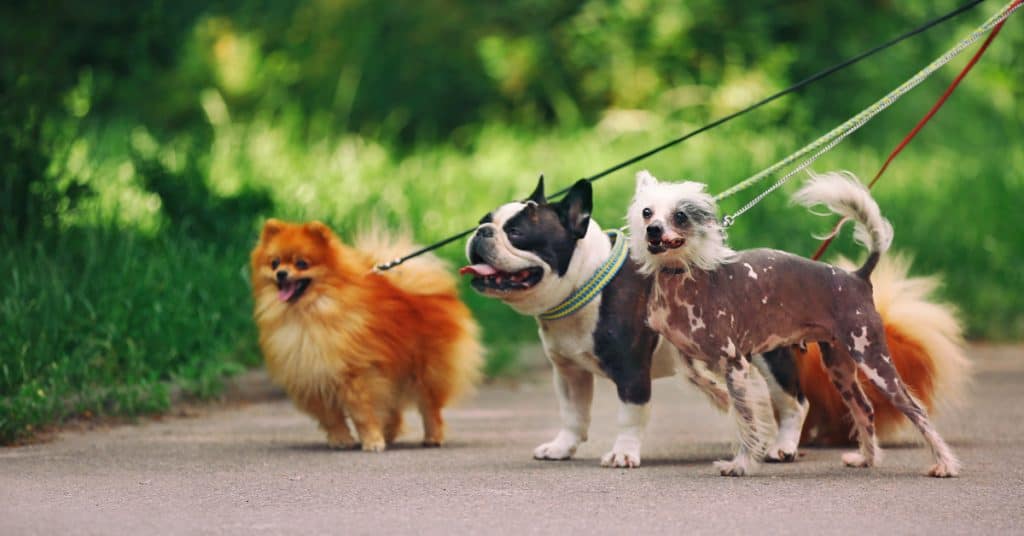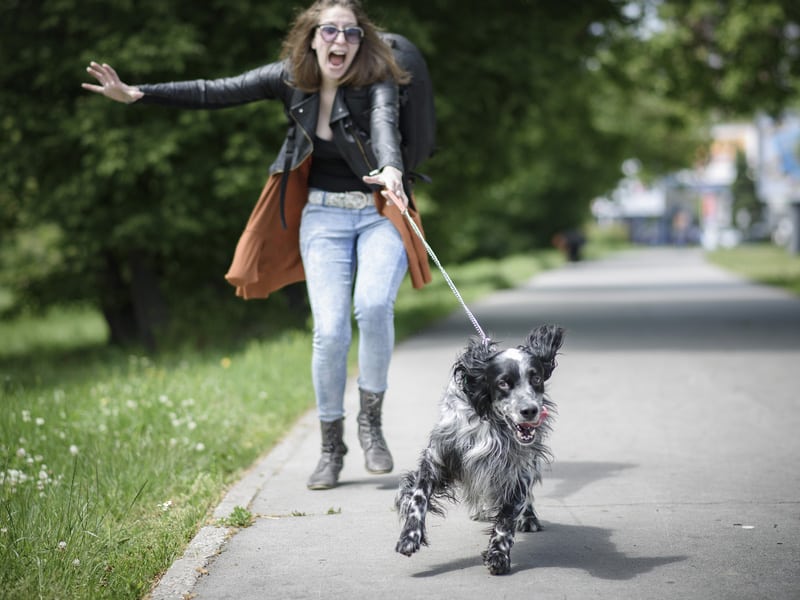
Has walking your dog turned into a constant game of tug-o-war with your furry family? Use these tips and tools to train your dog to stop pulling the leash.

If your dog has a tendency to drag you down the sidewalk during walks, you’re not alone! Leash pulling is one of the most common complaints among dog owners.
The outside world is very exciting for your dog. Between the interesting sights and smells, the tendency to encounter other dogs, cats, and wildlife during walks, and the fact that they generally just walk at a faster pace than their humans, it’s no surprise that dogs that aren’t taught otherwise will pull when they reach the end of their leash.
Fortunately, with patience, consistency, and clear communication with your dog, it’s easy to teach your dog to walk nicely! But, while the following steps are simple, they can take several days to several weeks to teach. Be prepared to go at your dog’s pace and offer praise and rewards for success. You’ll need to teach your dog that NOT pulling on their leash is more rewarding than pulling.
Here’s how to do it.


Teaching a Loose-Leash Walk:
Before getting started, make sure your dog is wearing a properly fitted collar (with identification tags!) and that you’re using a fixed length lead, not a retractable leash, no longer than 6-feet. Clip a treat pouch to your belt loop or waist, and make sure it’s filled with high-value training treats.
1. With your dog calmly by your side, begin taking a step forward. Your dog should remain close enough to you, either by your side or slightly ahead of you, that his leash remains loose, forming a U-shape from his collar to your hand.
2. The moment your dog reaches the end of his leash and begins to pull, stop walking. Do NOT allow him to move forward in the direction he’s pulling.
3. When he stops pulling and the leash returns to the loose U-shape, offer praise and treats. Then, begin walking forward again.
4. Repeat as often as necessary until your dog understands that pulling will prevent him from reaching his intended target.
That’s it! Sounds too easy, right?
For some dogs and their owners, it may take an entire week just to make it to the end of the driveway without stopping. This is where patience and consistency are key – and also where many pet parents fail. Remember, dogs will repeat behaviors that are rewarding for them. So, if even just once, you allow your dog to pull on a walk, he’ll keep trying until he learns it will never be rewarding.


Although clearly communicating what you expect of your dog is most important, there are some tools you can use to stop leash pulling from occurring while you’re training your dog.
No-Pull Harness: While some harnesses will actually encourage your dog to pull, some are designed especially to prevent it. Dogs have what is known as an “opposition reflex”, meaning, they will automatically push against pressure that’s applied to certain parts of their body. You may have discovered this when trying to teach a puppy to sit – when you push on their hind end, they don’t sit down as you’d expect. Instead, they push up against your hand! It’s important to keep this natural reflex in mind when choosing a harness.
Certain harnesses, like those used for sledding or pulling sports, clip on the dog’s back and apply pressure to your dog’s chest, encouraging them to push against that pressure. Instead, look for a no-pull harness that clips on the dog’s chest. That way, when the dog reaches the end of the leash and pulls, they’ll be redirected, unable to move forward in the direction they’re pulling.


Head Harness: Head harnesses can look a bit intimidating, but they’re very effective in stopping leash pulling, especially in larger and stronger dogs that pull. Head harnesses, like the Halti, slip over the dog’s head instead of around the neck or chest. When a dog wearing a head harness reaches the end of their leash and begins to pull, their head is turned, making them unable to continue pulling forward.
The biggest problem with these types of leads is that you can injure your dog if he snaps forward or if you pull back too suddenly. They are effective in initially laying the groundwork for proper walking etiquette, but your dog should be weaned from a head halter as soon as they’ve learned to walk nicely.
Other Tools: Parents of dogs that pull excessively on the leash may be tempted to resort to aversive tools to stop pulling. Tools like choke chains, prong collars, and electronic collars work by punishing a dog for pulling. When used improperly, these tools can cause pain and distress to your dog and do little to teach appropriate behaviors. Many dog owners find that their dog will walk nicely on leash when they’re wearing one of these specialty collars, but revert to pulling when a traditional collar is worn, indicating that they haven’t learned what’s expected of them on a walk.
Remember, although the above tools can be helpful in stopping leash pulling, they are not a replacement for training.
Found this article helpful? Pin it!





